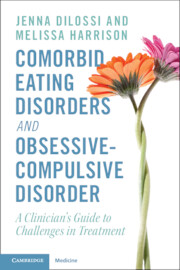 Comorbid Eating Disorders and Obsessive-Compulsive Disorder
Comorbid Eating Disorders and Obsessive-Compulsive Disorder Book contents
- Comorbid Eating Disorders and Obsessive-Compulsive Disorder
- Comorbid Eating Disorders and Obsessive-Compulsive Disorder
- Copyright page
- Contents
- Foreword
- Preface
- Acknowledgments
- Abbreviations
- Part I Overview of the Existing Literature
- Part II Clinical Pitfalls and Treatment Failures
- Chapter 7 Underweight and Malnourished Patients
- Chapter 8 Provider Collaboration in Eating Disorder Treatment
- Chapter 9 Impact of Eating Disorder Treatment on Obsessive-Compulsive Symptoms
- Chapter 10 The Relationship between Eating, Distress Tolerance, and Emotion Regulation in Obsessive-Compulsive Disorder
- Chapter 11 Poorly Executed Exposures
- Chapter 12 Considerations for Exposure Therapy in Eating Disorder Treatment
- Chapter 13 Subclinical Features as Treatment Barriers
- Part III Evidence-Informed Considerations for Assessment and Treatment
- Part IV Special Topics and Future Considerations
- References
- Index
Chapter 10 - The Relationship between Eating, Distress Tolerance, and Emotion Regulation in Obsessive-Compulsive Disorder
from Part II - Clinical Pitfalls and Treatment Failures
Published online by Cambridge University Press: 14 December 2023
- Comorbid Eating Disorders and Obsessive-Compulsive Disorder
- Comorbid Eating Disorders and Obsessive-Compulsive Disorder
- Copyright page
- Contents
- Foreword
- Preface
- Acknowledgments
- Abbreviations
- Part I Overview of the Existing Literature
- Part II Clinical Pitfalls and Treatment Failures
- Chapter 7 Underweight and Malnourished Patients
- Chapter 8 Provider Collaboration in Eating Disorder Treatment
- Chapter 9 Impact of Eating Disorder Treatment on Obsessive-Compulsive Symptoms
- Chapter 10 The Relationship between Eating, Distress Tolerance, and Emotion Regulation in Obsessive-Compulsive Disorder
- Chapter 11 Poorly Executed Exposures
- Chapter 12 Considerations for Exposure Therapy in Eating Disorder Treatment
- Chapter 13 Subclinical Features as Treatment Barriers
- Part III Evidence-Informed Considerations for Assessment and Treatment
- Part IV Special Topics and Future Considerations
- References
- Index
Summary
Individuals with OCD often engage in behaviors that help them avoid or escape anxious or distressing feelings. These behaviors can include typical compulsions seen in OCD, such as handwashing and checking, as well as maladaptive behaviors like substance use or problematic eating. These eating patterns can be a form of experiential avoidance, or the attempt to change or avoid negative thoughts, emotions, or physical sensations, even if it causes harm. Individuals with OCD have low distress tolerance (DT) or a limited capacity for enduring negative emotional experiences and a tendency to become overly reactive to stress and distress. Low DT is associated with a range of dysregulated behaviors and psychological disorders. DT relates to other affect intolerance and sensitivities, including emotional dysregulation, intolerance to uncertainty, anxiety sensitivity, negative urgency, and experiential avoidance. Studies have revealed that those with OCD tend to have more abnormal eating habits. which can be a way to escape or regulate emotions, avoid negative feelings, and, as a result, sustain maintenance variables in the OCD cycle.
- Type
- Chapter
- Information
- Comorbid Eating Disorders and Obsessive-Compulsive DisorderA Clinician's Guide to Challenges in Treatment, pp. 66 - 70Publisher: Cambridge University PressPrint publication year: 2023
